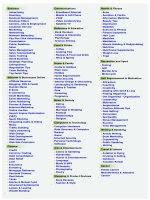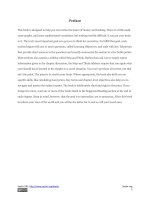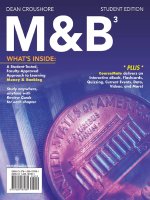Money and Banking: Lecture 5
Bạn đang xem bản rút gọn của tài liệu. Xem và tải ngay bản đầy đủ của tài liệu tại đây (294.48 KB, 17 trang )
Money and
Banking
Lecture 5
McGrawHill/Irwin
Copyright © 2006 by The McGrawHill Companies, Inc. All rights reserved.
Review of the Previous Lecture
• Five Parts of the Financial System
• Money
• Financial Instruments
• Financial Markets
• Financial Institutions
• Central Banks
• Measuring Money
• Definitions
• Monetary Aggregates
• Measures of Inflation
3-2
Topics under Discussion
• Financial Intermediaries
• Financial Instruments
•
•
•
•
Uses
Characteristics
Value
Examples
3-3
Financial Intermediaries
• The informal arrangements that were the
mainstay of the financial system centuries
ago have since given way to the formal
financial instruments of the modern world
• Today, the international financial system
exists to facilitate the design, sale, and
exchange of a broad set of contracts with
a very specific set of characteristics.
3-4
Financial Intermediaries
• We obtain the financial resources we need
from this system in two ways:
• directly from lenders and
• indirectly from financial institutions called
financial intermediaries.
3-5
Financial Intermediaries
Indirect Finance
•
•
a financial institution (like a bank) borrows
from the lender and then provides funds to
the borrower.
If someone borrows money to buy a car, the
car becomes his or her asset and the loan a
liability.
3-6
Financial Intermediaries
Direct Finance
• Borrowers sell securities directly to lenders in
the financial markets.
• Governments and corporations finance their
activities this way
• The securities become assets to the lenders
who buy them and liabilities to the borrower
who sells them
3-7
Financial and Economic Development
• Financial development is inextricably
linked to economic growth
• There aren’t any rich countries that have
very low levels of financial development.
3-8
Financial Instruments
• A financial instrument is the written
legal obligation of one party to
transfer something of value –
usually money – to another party at
some future date, under certain
conditions, such as stocks, loans,
or insurance.
3-9
Financial Instruments
• Written legal obligation means that it is
subject to government enforcement;
• the enforceability of the obligation is an
important feature of a financial instrument.
• The “party” referred to can be a person,
company, or government
• The future date can be specified or can be
when some event occurs
3-10
Financial Instruments
•
•
Financial instruments generally specify a
number of possible contingencies under
which one party is required to make a
payment to another
Stocks, loans, and insurance are all
examples of financial instruments
3-11
Characteristics of Financial Instruments
• Standardization
• Standardized agreements are used in order to
overcome the potential costs of complexity
• Because of standardization, most of the financial
instruments that we encounter on a day-to-day
basis are very homogeneous
• Communicate Information
• summarize certain essential information about the
issuer
• designed to handle the problem of “asymmetric
information”,
• borrowers have some information that they don’t disclose
3-12
to lenders
Classes of Financial Instruments
• Underlying Instruments (Primary or
Primitive Securities)
• e.g. Stocks and bonds
• Derivative Instruments
• value and payoffs are “derived from” the
behavior of the underlying instruments
• Futures and options
3-13
Value of Financial Instruments
1. Size of the promised payment.
•
•
People will pay more for an instrument that
obligates the issuer to pay the holder a
greater sum.
The bigger the size of the promised
payment, the more valuable the financial
instrument
2. When the payment will be received.
•
The sooner the payment is made the more
valuable is the promise to make it
3-14
Value of Financial Instruments
3. The likelihood the payment will be
made (risk).
•
The more likely it is that the payment will be
made, the more valuable the financial
instrument
4. The conditions under which the
payment will be made.
•
Payments that are made when we need
them most are more valuable than other
payments
3-15
Summary
• Financial Intermediaries
• Financial Instruments
• Uses
• Characteristics
• Value
3-16
Upcoming Topics
• Financial Instruments
• Examples
• Financial Markets
• Financial Institutions
3-17









